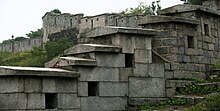Fortress Wall of Seoul
| Hanyangdoseong (Seoul City Wall) | |
 |
|
| Korean name | |
|---|---|
| Hangul | / |
| Hanja | / 서울 |
| Revised Romanization | Hanyangdoseong / Seoulseonggwak |
| McCune–Reischauer | Hanyangdosong / Seoulsongkwak |
The Hanyangdoseong (Hangul: 한양도성; Hanja: 漢陽都城), or literally the Seoul City Wall is a series of walls made of stone, wood and other materials, built to protect the city of Seoul against invaders. The wall was first built in 1396 to defend and show the boundaries of the city, surrounding Hanyang (hangul: 한양; hanja: 漢陽; the old name for Seoul) in the Joseon Dynasty. At that time, it was called Hansung (hangul: 한성; hanja: 漢城). The wall stretches 18.6 km along the ridge of Seoul's four inner mountains, Baegaksan, Naksan, Namsan, and Inwangsan. At present, a 12-km section of the wall is designated as Historic Site No. 10 (1963) and is protected accordingly, along with the gates, water gates, and signal fire mounds. Certain sections of the walls have undergone extensive restoration work, having sustained damage or been entirely destroyed in the city’s past.
In 1395, just five years after King Taejo founded the Joseon Dynasty, King Taejo established a government office [Doseongchukjoedogam (hangul: 도성축조도감; hanja: 都城築造都監)] to build a castle to defend Seoul. He ordered Jeong Do-jeon to search for and measure a site.
On January 1, 1396 (by the lunar calendar), Taejo of Joseon held the groundbreaking ceremony. 197,400 young men were placed under requisition over two years and completed building the castle 98 days after the war along the mountains Bugaksan, Naksan, Namsan, and Inwangsan. The wall contained eight gates, all of which were originally constructed between 1396 and 1398.
The original walls, built in the late 14th century were constructed of medium-sized round stones held together by mud. During King Sejong the Great’s reign in the mid 15th century, a large-scale refurbishment work was carried out on the wall, including the replacement of earthen wall sections with rectangular stone sections. A major restoration in 1704 by King Sukjong rebuilt sections of the wall using large, uniform stone slabs which mark the final and last unique characteristic of Hanyangdoseong.
...
Wikipedia
